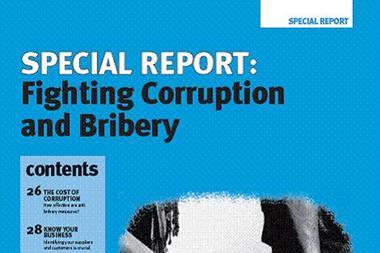There is probably no more corruption in the world now than there was 30 years ago, but corruption related risks for companies have substantially increased – particularly over the last decade – warns Robert Barrington
Corruption used to be taken for granted as a way of doing business. Until recently, many countries allowed bribes paid overseas to be tax deductible. It is now the subject of greater legislation and law enforcement. Leading companies report on it in their corporate responsibility reports, and have instituted zero tolerance policies.
There are three primary reasons why corruption risks have increased. First, there is the massive increase in global trade and, in particular, transactions and relationships involving countries that are high risk with regard to corruption, for example, sourcing from China or selling to India and Russia. Second, a more consistent and wide reaching international anti corruption legal framework has been put into place after the 1997 OECD Anti Bribery Convention and the 2003 United Nations Convention Against Corruption (UNCAC).
Finally, and perhaps most importantly, there has been a substantial increase in corruption related investigations and regulatory enforcement. However, efforts in this direction by the UK and other European countries pale into insignificance beside those of the Department of Justice in the US in enforcing the much feared Foreign and Corrupt Practices Act (FCPA). The FCPA incorporates several important principles, notably extra-territoriality. The sums levied in fines or agreed settlements have been eye-catching: $1.6bn in the Siemens case and $579m on Halliburton and associated companies over bribes relating to the Bonny Island project in Nigeria.
The challenge is what companies should do. This is particularly important in the light of new trends in legislation, in which having an effective anti corruption system in place can be a defence for an accused company. It will not prevent investigation and penalty, but it will help to exonerate senior executives and board members, enabling a case to be made that problems have arisen from rogue employees rather than company policy or systemic failures. In the recent Financial Services Authority ruling against Aon in the UK, the company was criticised for having a ‘weak control environment’. This included: poor risk assessment, especially in high risk markets; an inadequate system and controls with poor risk monitoring; a slow reaction to warning signals, and poor training.
The Aon case is instructive because, like the Woolf report that was commissioned after a series of allegations against BAE Systems, it demonstrates that we learn most about what regulators think is a good anti corruption system from what’s gone wrong. Interestingly, Aon received a 30% discount in its fine because it had cooperated fully with the authorities. Likewise, Siemens cooperated fully with the Munich and US authorities, and it has been estimated that without such cooperation, the case would have taken two to three times as long to resolve, potentially trebling the 1.5 million lawyer and forensic accounting hours involved. Regulators are strongly emphasising that self reporting and full cooperation are the quickest ways to a favourable and less costly resolution of cases.
“Having an effective anti corruption system in place can be a defence
Avoidance of problems in the first place is clearly critical for companies, and there are three simple steps that can be taken to mitigate the risks. A good starting point is board level sign off of business principles that have a zero tolerance approach to bribery. Transparency International’s Business Principles for Countering Bribery is one of three codes accepted by the UN as demonstrating compliance with the anti corruption principles of the Global Compact, along with the International Chamber of Commerce code and the World Economic Forum’s PACI principles. These codes cover areas including political contributions, charitable donations, gifts, hospitality and facilitation payments – all potential pitfalls.
Next, there needs to be a thorough risk assessment of where the business is exposed to corruption risks. Among the tools used in the risk assessment are likely to be two developed by Transparency International and available at www.transparency.org. The Corruption Perceptions Index highlights which countries are high risk. The Bribe Payers Index shows which countries’ companies are most likely to pay bribes, and which sectors are most vulnerable. Certain types of transaction are particularly high risk. Using local agents, entering into contracts or joint ventures with state-owned companies, and dealings with government officials or politicians (known as politically exposed persons or PEPs) are all high risk.
Finally, there is a need for good training. The transactions that involve straightforward passing over of cash to receive a contract or permit have become less common as corruption has become more sophisticated. It is more likely to be found in the provision of payments or services to a corrupt official’s family members or nominated charity, or a requirement to do business with a specific counter party. This complexity makes corruption difficult to trace, and also makes it necessary for employees to be properly trained in the pitfalls and the legal sanctions they and their company face if they make a wrong decision.
No system is foolproof, but in the corruption arena, most companies do not have a system at all. However, as corruption risks are rising, companies need to respond to them. It is likely that in both the US and Europe there will be an increasing number of high profile cases with high fines and prison sentences. Most of the companies involved in investigations to date did not know they had a problem until investigators came knocking on the door. That should be worrying for any business.
Postscript
Robert Barrington is director of external affairs, Transparency International (UK)



















No comments yet